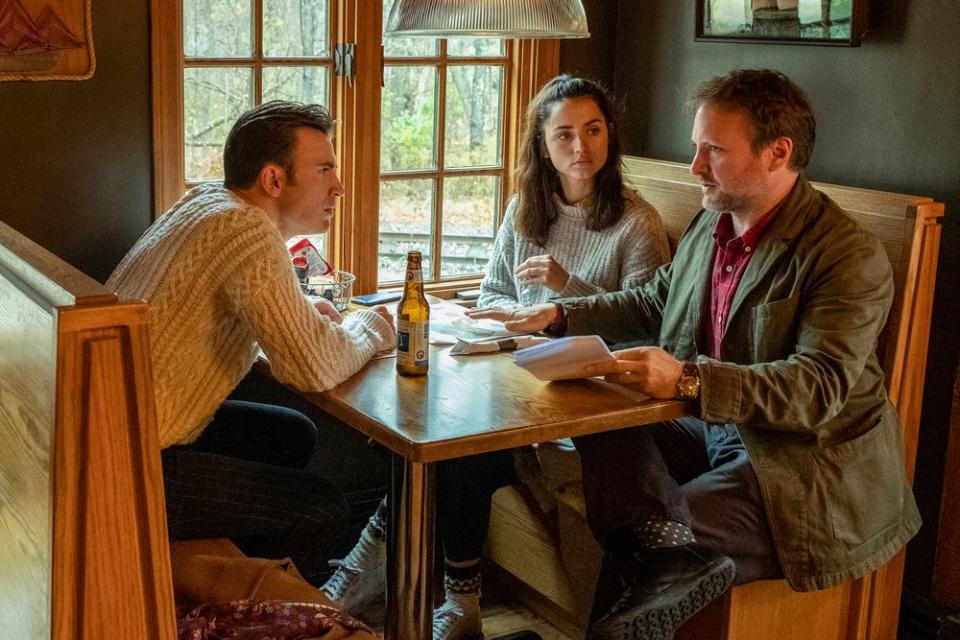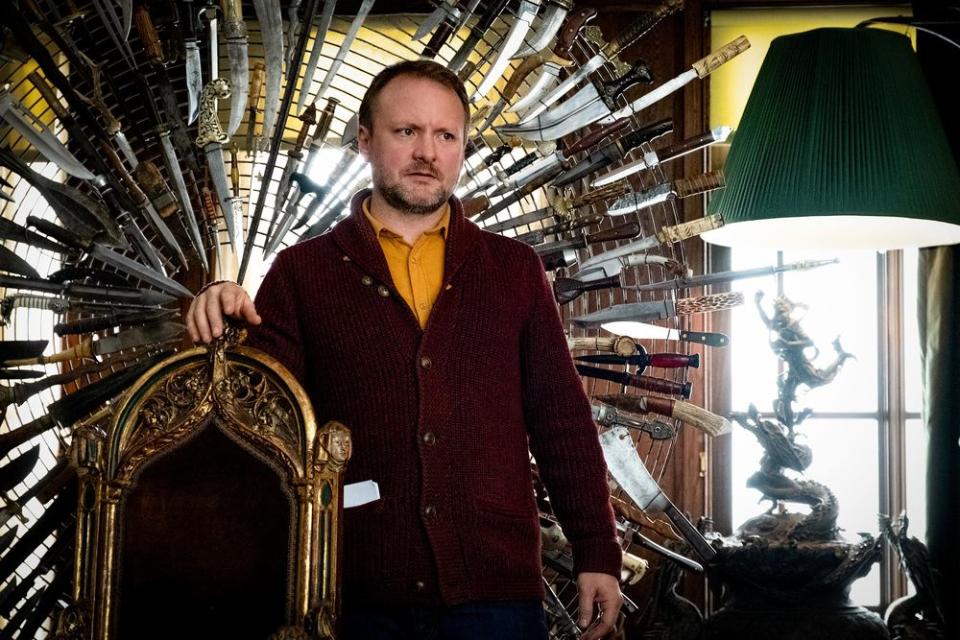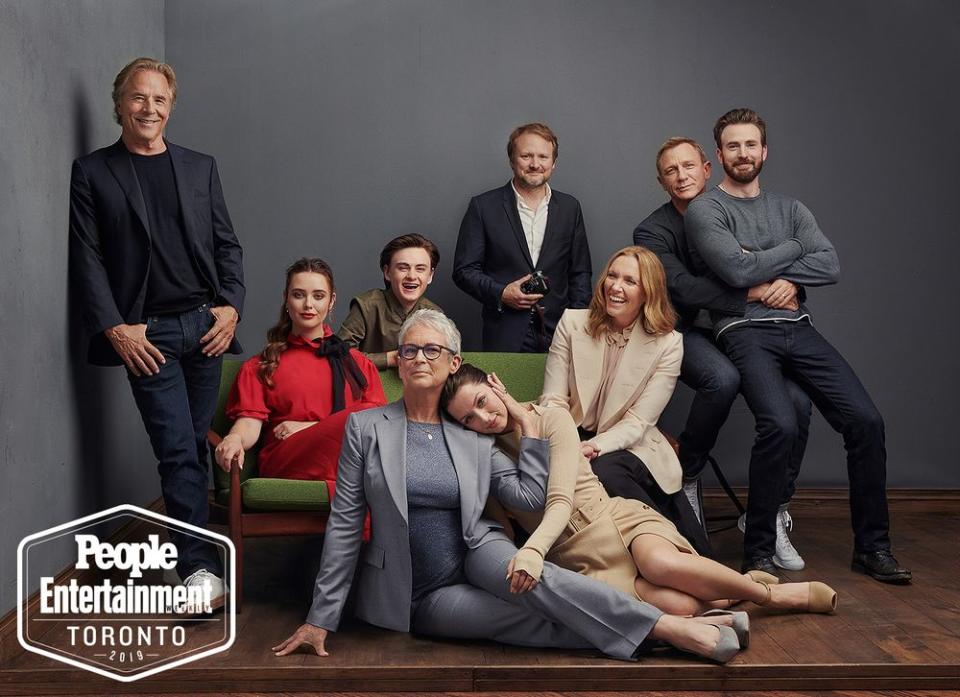How Rian Johnson wrote Knives Out, the best cinematic whodunit in years
With Knives Out, Rian Johnson got to make a movie within the genre he’s loved for much of his life: the whodunit.
It’s a star-studded, comically mysterious affair in the vein of the blockbuster Agatha Christie adaptations the writer-director grew up watching. And with excellent reviews coming out of its September premiere in Toronto, and box-office prospects looking very good ahead of its apt Thanksgiving holiday release — the film follows a family of wealthy troublemakers who gather after the patriarch (Christopher Plummer) is murdered — awards buzz is building, particularly for Johnson’s script.
EW caught up with Johnson about how the film looked over a decade ago when he first had an idea, making room for such special and unexpected performances, and the balance between keeping viewers off balance and building to a satisfying final twist. Read on below. Knives Out hits theaters Wednesday.

ENTERTAINMENT WEEKLY: You first had the idea for a whodunit like this over a decade ago, correct?
RIAN JOHNSON: Yeah, yeah. Just the very basic idea for it.
So what did that initial seed look like to you? Why did the genre interest you?
Well I had wanted to do a whodunit forever. I grew up reading Agatha Christie’s books; it’s a genre that I deeply, deeply love. It’s been a comfort food for me. I always wanted to do a straight-up whodunit. The first idea was a very conceptual one: As I thought about doing a whodunit, I thought about Hitchcock and his opinion of whodunits. He always said they rely entirely on surprise — one big surprise at the end — and that’s the weakness of them narratively. Especially when you put them up on-screen; with a book, you can put the book down, you can come back to it, you can re-engage. A movie has to be a rollercoaster ride. Clue-gathering leading up to a guess that you might be right or wrong about the end is not that thrilling — even though I love the genre. The notion of doing a whodunit that begins as a traditional whodunit and orients the audience very clearly, and then turns into a Hitchcock thriller where there’s a character you care about — you’re leaning forward as opposed to leaning back. Then turns back into a whodunit at the end and reveals it’s been a whodunit the whole time; the thriller element was a whole bit of misdirection. I got very excited about the idea of making a movie that was narratively engaging but also let me have my cake and eat it too in terms of all the whodunit tropes that I love and that I could still get in there.
You weave between these two conventions and, in many ways, honor them. As you were writing, were you researching and thinking about how to hew to those structures, or trying more to do your own thing, and work off your love of these genres and what you already knew?
I’m so familiar with the genre — I still today watch every whodunit that comes out, I’m a junkie. I did a little bit of specific studying, structurally. As I went forward I did get nervous that it was too long, and I went back and double-checked and was like, “No, it’s okay.” But largely it was, blind my vision and try to find in a general sense the heart of what I engage with and really love in a good whodunit — as opposed to going back and looking to any specific one for inspiration.
So how important was it to you that people not figure it out? I’ve talked to people who — in a good way! — were like, “Oh, I figured it out,” and other people who were totally surprised by the end. Obviously you’re finding that balance between the twist not coming out of thin air, and keeping viewers on their toes. Where did you fall there?
It’s more fun if there’s an element of surprise at the end, but honestly, I purposefully tried to have the movie not [rely] on that. I hoped the movie was as entertaining whether you guessed it or not. That’s my ultimate hope. The game it’s playing, hopefully, there is some element of surprise at the end. But the bigger goal, for me, was to build it so as a dramatic ending it works. Even the payoff at the end: The really satisfying payoff at the end is not the reveal of whodunit; it comes after that. It’s the dramatic payoff to this protagonist we’ve been following and her relationship to this family. That was done very purposefully on my part, to shore up and protect against the possibility that some people are going to figure it out because they’re smarter than me. [Laughs] Or just because of luck. You pick the right person, there you go. Making sure they still feel satisfied with the end of the film is part of my job.

I wanted to ask you about conceiving a few of the characters, starting with Detective Blanc. Daniel Craig gives such a weird, wonderful performance. How did the character initially come to you, and how did Daniel shape him from there?
I started in a very unproductive place. I love the character of Poirot so much and I ended up just creating a version that was just a bunch of crazy quirks. Finally I said, “You know what, I have to take the same approach to writing a detective as I am to the movie itself, and think about the dramatic purpose of the character.” I stepped back, I stripped all the eccentricities out, I gave him a Southern accent — figuring it’d help him be a fish out of water amongst these New England WASPs — and I wrote the character on the page with a voice, with a slight sense of self-importance. He likes the sound of his own voice. I tried to write him fairly straightforward. I figured whoever I would find, I would collaborate with to find the eccentricities. When Daniel ended up playing the part, we got into it. We figured out exactly what region the accent would be from. I talked to him about Peter Ustinov’s performance as Poirot — the essential clownishness that he found in the character while still keeping him grounded. Daniel had grown up watching those movies as well, so he knew what I was talking about. We didn’t change much from what was on the page, but the character slowly took shape as Daniel inhabited it.
You also have Chris Evans playing a jerk and Toni Collette doing her Goop thing.
[Laughs]
Some of these feel very against-type in a very fresh way. I’m broadly interested in your casting philosophy, from sketching these characters out to bringing them to life.
First and foremost, trying to get great actors who are going to play the parts well. If there’s any second layer to it, any meta layer, it’s that I wanted an all-star cast — again, to emulate those films that I grew up watching. Death on the Nile: big, all-star casts where everyone who shows up on screen, you’re like, “Oh, it’s that person!” I had that in mind. Daniel and Chris are probably the two who audiences would probably consider playing against-type the most. It was less for me about the audience’s perception than that I could tell we were going to have a lot of fun cutting loose and doing something very different than what they had just done. Given the tone of what we were going for, if we’re having fun, that will translate to the audience.
On the other side you have Marta (Ana de Armas), and she gives you in the movie an opportunity to talk about class and wealth. Talk a little bit about employing the constraints of genre — or the opportunities of genre — to get these bigger ideas across.
It’s funny, the whodunit genre is specifically suited to examining class, in my favorite type of way with any kind of thematic layer to a movie — it perfectly works because it’s expressed through the mechanics of the genre itself. The fact that you have a rich gathering of suspects, and the fact that those suspects are going to be a diverse group from the high to the low of shows what a microcosm of society’s power structures is. In this case, it’s a family; but it’s always something. In Gosford Park, it was the whole upstairs-downstairs of an English monarchy. Because of that, whodunits have always done that. One thing they haven’t really been used for, though, is doing that in modern-day America. We usually see them as period pieces set in Britain. We’re all very familiar with that. So that seems exciting to me — using the strength of the genre and applying them to the modern world.
Did you find as you got deeper into the script, these ideas started crystallizing? Or was it something you really set out to do from the beginning?
The basics of it were there from the beginning. Again, I had the basic idea 10 years ago; the fundamental idea of Marta as the protagonist and inside but also outside the family; the relationships and power structures of the family evolving as the screws are turning. I had that for a long, long time. The fundamental thing we’re talking about is engaging with something politically [right now], but more than that, it’s engaging on a human level.

Earlier you’d mentioned the thriller segment of the film as being its own kind of red herring. I love the red herrings in this movie because they offer great character moments in places where actors can really shine. No whodunit is complete without them, of course, but can you talk about how you saw a creative opportunity in them?
With a movie like this, it’s part of the fun: setting the table with a very specific genre that everybody is familiar with. Part of the benefit of doing that is that you know the audience is sitting down with expectations in the head. In the case of a whodunit, they’re leaning into everything. They’re looking for red herrings everywhere. You don’t need to plant red herrings! You don’t need to plant false pathways and clues. I found you can just play it very, very straight. So the audience is going to lead us to things you never would’ve expected; they’ll do the heavy lifting for you in that regard. In that way, I tried to make a deft film with lots of information in it, but in truth, I tried to play it straight and serve the story, and leave the audience to misdirect themselves.
In terms of the relationship between your writing and your directing, for a movie like this which has such a specific vibe, how did you craft the script with an eye toward filming it? What kinds of choices did you make in those beginning stages?
It’s a good question, it’s weird — on one hand, there is a real separation between when I’m writing and when I’m on-set directing. In many ways when you’re on set, it feels like you can’t be precious about the words. I’ve used the analogy before that writing is like when the generals are in the war-room, with maps spread out on the table, making their grand plans, and then when you’re directing, you’re actually in the trenches with the troops, trying to actually make it work. You just have to take the hill. [Laughs] At the same time, when I’m writing, I am directing in my head. I can’t write a scene unless I can see it visually and also have a sense of tonally and otherwise how it’s going to play. That may very much change when we get on set. It’s a very messy relationship, made messier by the fact that it’s the same person doing both parts. I don’t know! Very good question that I obviously did not have an articulate answer to.
No, it’s so interesting to me! Having done it a few times, do you think this messy relationship, as you say, has evolved at all?
Oh sure, every movie is such a huge learning curve. I’ve probably gotten less precious about the words on the page as I get on-set, and more comfortable with improvisation, working with actors, adjusting and keeping it fluid — what feels right, let’s find another way to it. Trying to keep the thing that’s precious be the intent of the scene. Usually, what’s on the page is what we do, but if something’s not feeling right, I have the confidence to say, “Okay, let’s find another way to that.”
This interview has been edited and condensed.
Related content:

